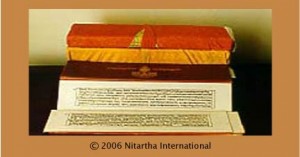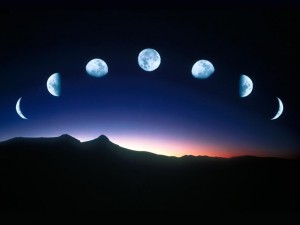
The following is respectfully quoted from “The Practice of Dzogchen” by Longchen Rabjam translated by Tulku Thondup:
Sources of the Major Tantric Scriptures
According to the history of the tantric scriptures, most of the tantras of the New Translation School of Tibet—such as Guhyasamaja and Kalachakra and the tantras belonging to the division of Outer Tantras—were expounded by Sakyamuni Buddha. But the tantras of the three Inner Tantras of the Old Translation School did not originate with Sakyamuni Buddha.
The original tantras of Mahayoga and Anuyoga first appeared in the human realm when they were received by a group of five Buddhist adepts called the Five Excellent Beings (Dam Pa’I Rigs-Cham Dra-Ma lNga) from Vajrapani Buddha in a pure vision on Mt. Malaya [Sripada, Srilanka?] twenty-five years after Mahaparinirvana, the passing away of Sakyamuni Buddha. They were then transmitted to King Jha (Dza) of the Oddiyana kingdom by Trimed Tragpa (Dri-Med Grags-Pa, Vimalakirti) of the Lcchavi tribe, who was one of the Five Excellent Beings.
In Mahayoga, in addition to tantras there is another category of scriptures known as the sadhanas [propitiations]. The following eight categories of scriptures of the sadhana section of Mahayoga were received in two ways, in canonical (bKa’-Ma) form and discovered treasure (gTer-Ma) form.
a) The following scriptures were received by different masters by means of canonical transmission, which means transmission from person to person: Vajraheruka (or Yang-Dag) scriptures received by Humkara, Yamantaka by Manjusrimitra, Hyagriva by Nagarjuna, Vajramrta (bDud-rTsi ‘Khyil-Ba) by Vimalamitra, and Vajrakilaya by Prabhahasti and Padmasambhava.
b) Discovered Treasure Sadhanas: The following scriptures were concealed and entrusted by Dakini Lekyi Wangmo (Las-Kyi dBang-Mo) to the following masters, and those scriptures are known as the discovered treasure Sadhanas: Sriheruka (Ch’e-mCh’og) scriptures entrusted to Vimalamitra, Vajraheruka to Humkara, Yamaraja to Manjusrimritra, Hyagriva to Nagarjuna, Vajrakilaya to Padmasambhava, Mamo (Ma-Mo) to Dhanasamskrta, Chod-tod (mCh’od-bsTod) to Rombhuguhya, and Trag-ngag (Drag-s Ngags) to Santigarbha. She also entrusted the Desheg Dupa (bDe-gShegs ‘Dus-Pa) to Padmasambhava. Those masters transmitted the teachings to their disciples and most of them are in practice today.
The original tantras of Atiyoga were received in pure vision by Garab Dorje (dGa’-Rab rDo-rJe, S. Prahevajra), the first human master of Atiyoga, directly from Vajrasattva, a Buddha in Sambhogakaya form. He transmitted them to Manjushrimitra. The teachings of Atiyoga were brought to us through various lineages and are known in Tibetan as Dzogpa Chenpo, the Great Perfection, which is the subject of this book.
Some Major Tantric Scriptures of the Three Inner Tantras
The scriptures of Inner Tantras which have survived are preserved as the collections of Nyingma Gyud-bum (rNying-Ma rGyud-‘Bum) in twenty six volumes. There are different ways of classifying the tantras, and I have indicated the sources on which I relied to make the following lists.
The Tantras of Mahayoga
Mahayoga scriptures were brought to Tibet by Indian scholars and Tibetan translators including Guru Padmasambhava, Vimalamitra, Santigarbha, Jnanagarbha, Vairocana, Namkha’I Nyingpo (Nam-mKha’I Nying-Po), and Sangye Yeshey (Sang-rGyas Ye-Shes). In Mahayoga there are two major sections of scriptures, the eighteen tantras and the sadhanas. According to Gyurmed Tshewang Chogdrub, who says the list is based on the writings of Terchen Gyurmed Dorje (1646-1714), the major tantras of Mahayoga are as follows:
1) Tantra Section:
a) The Root of all the Mahayoga Tantras, the tantras of Guhyagarbhamayajala-tantra entitled: Dorje Sempa Gyuthrul Trawa Tsawa’I Gyud Sangwa Nyingpo (rDo-rJe Sems-dPa’ rGyu-‘Phrul Drva-Ba rTsa-Ba’I rGyud gSang-Ba sNying-Po)
b) The Explanatory Tantras:
Five Major Tantras:
i) Tantra of Body: Sangye Nyamjor (Sang-rGyas mNyam-sByor)
ii) Tantra of Mind: Sangwa Dupa (gSang-Ba ‘Dus-Pa)
iii) Tantra of Virtues: Palchog Tangpo (dPal-mCho’g Dang-Po)
iv) Tantra of Action: Karma Male (Karma Ma-Le)
Five Tantras of Sadhana:
i) Heruka Rolpa (Heruka Rol-Ba, missing)
ii) Tachog Rolpa (rTa-mCh’og Rol-Ba)
iii) Nyingje Rolpa (sNying-rje Rol-Ba)
iv) Dudtsi Rolpa (bDud-rTsi Rol-Ba)
v) Phurba Chunyi (Phur-Pa bChu-gNyis)
Five Tantras of Actions:
i) Lanchen Rab-bog (Glang-Ch’en Rab-‘Bog)
ii) Riwo Tsegpa (Ri-Bo brTsegs-Pa)
iii) Yeshey Ngamlog (Ye-Shes rNgam-Glog)
iv) Tamtshig Kodpa (Dam-Tshig bKod-Pa)
v) Tingdzin Tsechig (Ting-‘Dzin rTse-gChig)
(The last four tantras are common to Anuyoga)
Two Supplementary Tantras:
i) According to PKD bb/3: Namnang Gyuthrul Trawa (rNam-sNang sGyu-‘Phrul Drva-Ba).
ii) Thabkyi Zhagpa (Thabs-Kyi Zhags-Pa)
2) Sadhana [Ppropitiation] Section:
The scriptures of Sadhanas of Eight Great Mandalas of Deities (sGrub-Pa bKa’-brGyad) of which there are two kinds, the Canonical (bKa’-Ma) and Discovered Treasure (gTer-Ma) scriptures. The Eight Great Mandalas of Deities are: (a) Yamantanka of Body, (b) Hayagriva of Speech, (c) Vajraheruka (Yang-Dag) of Mind, (d) Dudtsi Chechog (bDud-rTsi Che’-mCh’og) of Virtues, (3) Vajrakilaya of Action, (f) Mamo Bod-Tong (Ma-Mo rBod-gTong), (g) Jigten Chod-tod (‘Jigs-rTen mCh’od-bsTod) and (h) Modpa Trag-ngag (dMod-Pa Drag-sNgags).
The Tantras of Anuyoga
The Anuyoga tantras were brought to Tibet by Vimalamitra, Vairocana and especially by Nubchen Sangye Yeshey (gNub-Ch’en Sangs-rGyas Ye-Shes). According to Gyurmed Tsewang Chogdrub, among the Anuyoga tantra are:
1) Four Root Tantras:
a) Kundu Rigpa’I Do (Kun-‘Dus Rig-Pa’I mDo)
b) Sangye Thamched Gongpa Dupa (Sangs-rGyas Tham-Chad dGongs-Pa ‘Dus-Pa)
c) Yeshey Ngamlog (Ye-Shes rNgam-Glog)
d) Turthrod Khuchug Rolpa (Dur-Khrod Khu-Byug Rol-Ba)
2) Six Branch Tantras:
a) Kunto Zangpo Chewa Rangla Nepa’i Gyud (Kun-Tu bZang-Po Ch’e-Ba Rang-La gNgas-Pa’I rGyud)
b) Wangkur Gyalpo (dBang-bsKur rGyal-Po)
c) Tingdzin Chog (Ting-‘DZin mCh’og)
d) Kabjor Dunpa (sKabs-sByor bDun-Pa)
e) Tsonpa Donden (brTson-Pa Don-lDan)
f) Tamshig Kodpa (Dam-Tshig bKod-Pa)
3) Twelve Rare Tantras:
a) Zhiwa Lhagyud (Zhi-Ba Lha-rGyud)
b) Chonyid Zhiwa’i Lhagyud (Ch’os-Nyid Zhi-Ba’I Lha-rGyud)
c) Throwo’I Lhagyud Chenmo (Khro-Bo’I Lha-rGyud Ch’en-Mo)
d) Throwo’I Lhagyud Kyi Togpa Chenpo (Khro-Bo’I Lha-rGyud Kyi rTogs-Pa Ch’en-Po)
e) Thugje Chenpo’i Torgyud (Thugs-rJe Ch’en-Po’i gTor-rGyud)
f) Naljor Nangpa’i Tsog-gyud Chenpo (rNal-‘Byor Nang-Pa’i Tshogs-rGyud Ch’en-Po)
g) Palbar Khroma (dPal-‘Bar Khros-Ma)
h) Rakta Markyi Gyud (Rakta dMar-Gyi rGyud)
i) Melha Zhiwar Kyurpa Barwa’i Gyud (Me-Lha Zhi-Bar Kyur-Pa ‘Bar-Ba’i rGyud)
j) Throwo’i Jinseg (Khro-Ba’i sByin-bSreg)
k) Hungdzed Chenpo (Hung-mDzad Ch’en-Po)
l) Dasang Chenpo (Zla-gSang Ch’en-Po)
The Tantras of Atiyoga
Atiyoga has three divisions of tantras: They are Semde, Longde, and Mengagde.
1. In Semde (Sems-sDe) there are Twenty-one Major Tantras which were brought to Tibet by Vimalamitra and Vairocana. According to Longchen Rabjam they are:
A) The Five Earlier Translated Tantras, translated by Vairocana:
a) Rigpa’i Khuchug (Rig-Pa’i Khu-Byug)
b) Tsalchen Trugpa (rTsal-Ch’en Drug-Pa)
c) Khyungchen Dingwa (Khyung-Ch’en lDing-Ba)
d) Dola Serzhun (rDo-La gSer-Zhun)
e) Minubpa’i Gyaltshen Namkhache (Mi-Nub-Pa’i rGyal-mTshan Nam-mKha’-Ch’e)
B) The Thirteen Later Translated Tantras, translated Tantras, translated by Vimalamitra, Nyag Jnanakumara and Yudra Nyingpo (gYu-sGra sNying-Po):
a) Tsemo Chung-gyal (rTse-Mo Byung-rGyal)
b) Namkha’i Gyalpo (Nam-mKha’i rGyal-Po)
c) Dewa Thrulkod (bDe-Ba ‘Phrul-bKod)
d) Dzogpa Chinching (rDzogs-Pa sPyi-Ch’ings)
e) Changchub Semtig (Byang-Ch’ub Sems-Tig)
f) Dewa Rabjam (bDe-Ba Rab-‘Byams)
g) Sog-gi Khorlo (Srog-Gi ‘Khor—Lo)
h) Thigle Trugpa (Thig-Le Drug-Pa)
i) Dzogpa Chichod (rDzogs-Pa sPhi-sPyod)
j) Yidzhin Norbu (Yid-bZhin Nor-bu)
k) Kundu Rigpa (Kun-‘Dus Rig-Pa)
l) Jetsun Tampa (rJe-bTsun Dam-Pa)
m) Gompa Tontrub (sGom-Pa Don-Grub)
C) Three Outher Major Tantras:
a) The cycle of Kunched Gyalpo (Kun-Byed rGyal-Po)
b) The Medchung (rMad-Byung)
c) The Thirteen Sutras of Semde
2. The tantras of Longde (Klong-sDe) were brought to Tibet by Vimalamitra and Vairocana. According to Gyurmed Tsewang Chogdrub, some of the major tantras of Longde are:
a) Longchen Rabjam Gyalpo (Klong-Ch’en Rab-‘Byams rGyal-Po)
b) Kunto Zangpo Namkhache (Kun-Tu bZang-Po Nam-mKha’-Che)
c) Rigpa Rangtsal Sharwa (Rig-Pa Rang-rTsal Shar-Ba)
d) Dam-ngag Natshog Khorlo (gDams-Ngag sNa-Tshogs ‘Khor-Lo)
e) Phaglam Kodpa (‘Phags-Lam bKod-Pa)
f) Dorje Sempa Namkha’i Thatang Nyampa (rDo-rJe Sems-dPa Nam-mKha’i mTha’-Dang mNyam-Pa)
g) Yeshey Sangwa Dronma (Ye-Shes gSang-Ba sGron-Ma)
h) Rinpoche Khorlo (Rin-Po-Ch’e ‘Khor-Lo)
i) Yeshey Sangwa (Ye-Shes gSang-Ba)
j) Yeshey Dzogpa (Ye-Shes rDzogs-Pa)
k) Changchub Kyi Sems Kunla Jugpa Namtag Tonpa (Byang-Ch’ub Kyi Sems Kun-La “Jug-Pa rNam-Dag sTon-Pa)
l) Changchub Kyi Sem Dorje Odthro (Byang-Ch’ub Kyi Sems rDo-rJe A’od-‘Thro)
3. The Tantras of Mengagde (Man-Ngag-sDe) were brought to Tibet mainly by Pandita Vimalamitra and Guru Padmasambhava. Some of the major tantras of Mengagde, which belong to Yangsang (Yang-gSang) orNyingthig (sNying-Thig) subdivision, according to Gyurmed Tshewang Chotrub and Pema Ledreltsal are:
- The Seventeen Tantras (rGyud-bChu-bDun):
a) Dzogpa Rangchug (rDzogs-Pa Rang-Byung)
b) Yige Medpa (Yi-Ge Med-Pa)
c) Rigpa Rangshar (Rig-Pa Rang-Shar)
d) Rigpa Rangtrol (Rig-Pa Rang-Grol)
e) Rinpoche Pungwa/Pudpa (Rin-Po-Che’ sPung BalsPud-Pai)
f) Kudung Barwa (sKu-gDung ‘Bar-Ba)
g) Dra Thalgyur (sGra Thal-‘Gyur)
h) Trashey Dzeyden (bKra-Shis mDzes-lDan)
i) Dorje Sempa Nying-gi Melong (rDo-rJe Sems-dPa’ sNying-Gi Me-Long)
j) Kuntu Zangpo Thugkyi Melong (Kun-Tu bZang-Po Thugs-Kyi Me-Long)
k) Ngotrod Trepa (Ngo-sProd sTras-Pa)
l) Mutig Rinpoche’I Threngwa (Mu-Tig Rin-Po-Ch’e’I Phreng-Ba)
m) Kuntu Zangpo Longtrub (Kun-Tu bZang-Po Klong-Drug)
n) Dronma Barwa (sGron-Ma ‘Bar-Ba)
o) Nyida Khajor (Nyi-Zla Kha-sByor)
p) Seng-ge Tsaldzog (Seng-Ge rTsal-rDzogs)
q) Norbu Trakod (Nor-Bu Phra-bKod)
- Two Other Major Tantras:
a) Ekatsati Nagmo Throma (Ekajati Nag-Mo Khros-Ma)
b) Longsal Barma (Klong-gSal ‘Bar-Ma)
There are two other important categories of scriptures in the Yangsang sub-section of Mengagde, known as Instructional (Man-Ngag) category of teachings. They are as follows. According to Pema Ledrel Tsal the first is the Nyingthig teachings which contain the essential instructions of the Seventeen Tantras and Throma Tantra It was brought to Tibet by Vimalamitra and became known as Vima Nyingthig. The second is the Nyingthig teachings which mainly contain the essential instructions of Longsal Barwa Tantra. It was brought to Tibet by Guru Padasambhava and became known as Khadro (mKha’-‘Gro) Nyingthig.
Longchen Rabjam wrote a volume of commentarial and supplemental texts on Vima Nyingthig known as Vima Yangtig (Vima Yang-Tig) and one volume on Khadro Nyingthig known as Khadro Yangtig (mKha’-Gro Yang-Tig). He also wrote a volume on both Nyingthigs known as Lama Yangtig (Bla-Ma Yang Tig) or Yangtig Yidzin Norbu (Yang-Tig Yid-bZhin Nor-Bu). These two root scriptures and two commentarial texts are known as Nyingthig Yazhi (sNying-Thig Yab-Zhi), the Four Volumes of Nyingthig. They are some of the most important texts and writings on Nyingthig.

